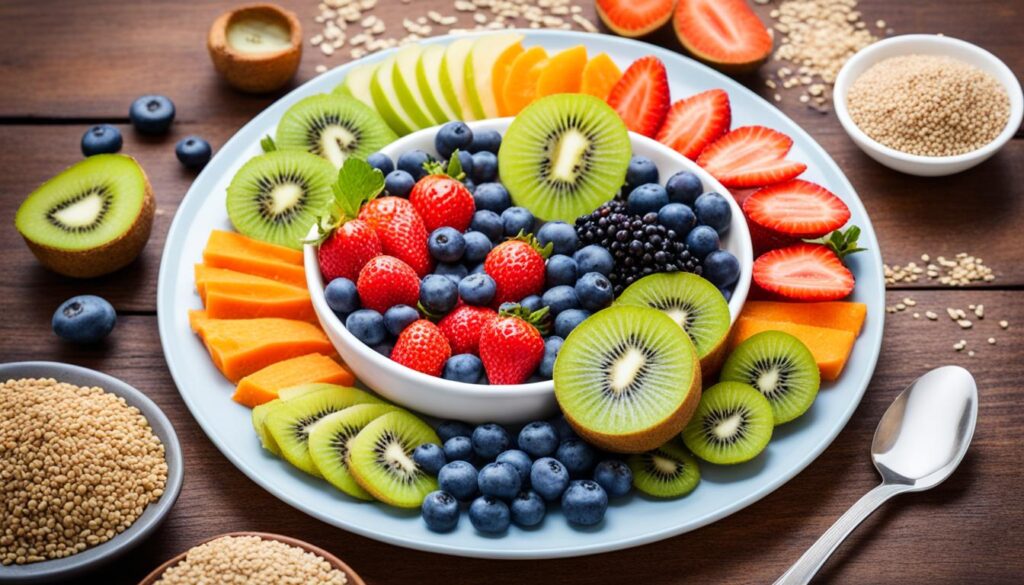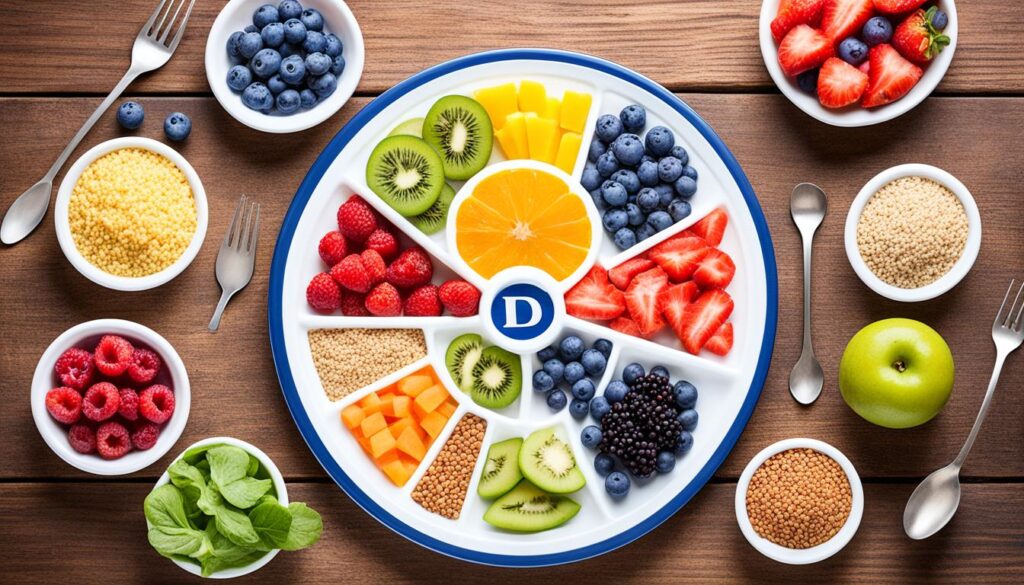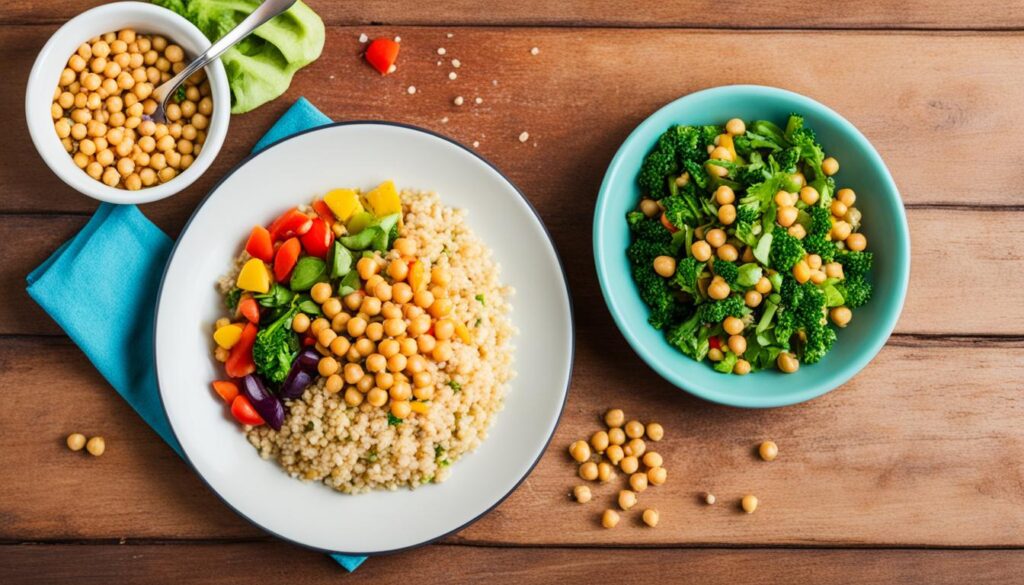Are you tired of fighting with your diet because you have diabetes? Imagine a world where managing your blood sugar is easy and empowering.
We’re about to share the secrets of the best diet plan for diabetics. Are you ready to take charge of your health and beat diabetes?
Key Takeaways
- A diabetes diet is a healthy-eating plan that helps control blood sugar levels.
- Eating regular, balanced meals with a focus on fruits, vegetables, and whole grains can effectively manage diabetes.
- Incorporating heart-healthy fats and limiting saturated and trans fats is crucial for diabetic individuals.
- Meal planning strategies like the plate method and carbohydrate counting can assist in maintaining stable blood sugar levels.
- Personalized nutrition guidance from a registered dietitian can help create a tailored diet plan for optimal diabetes management.
What is a Diabetes Diet?
A diabetes diet is a plan that helps control blood sugar levels. It focuses on foods that are low in fat and calories. Foods high in carbs and calories can raise your blood sugar. This can lead to serious health problems like nerve, kidney, and heart damage.
A diabetes diet offers a nutritious way to manage blood sugar and safely reach weight goals.
Understanding the Basics
Eating the healthiest foods in moderation is key to a diabetes diet. Experts suggest starting with a low-carb diet to manage type 2 diabetes. This can help lower high blood glucose levels.
This diet includes lots of fruits, veggies, fish, chicken, nuts, olive oil, legumes, and whole grains. It limits red meat, butter, and salt.
The Mediterranean diet is also good for diabetes. It’s full of fruits, veggies, low-fat dairy, whole grains, lean meats, fish, nuts, and beans. This diet can improve insulin sensitivity and is great for weight loss with exercise.
A balanced diet for diabetes has 40% carbs, 30% protein, and 30% fat. It focuses on good carbs for better glycemic control and waist size.
Consistency in carb intake at each meal and snack is advised, helping individuals manage their blood sugar more effectively.
Why is a Diabetes Diet Important?
Following a diabetes diet is key to managing blood sugar and preventing complications. This plan helps people with diabetes make healthy food choices and keep track of what they eat. By sticking to a diabetes diet, individuals can keep their blood sugar stable and lower the risk of heart disease and some cancers.
One big plus of a diabetes diet is it boosts bone health. Eating low-fat dairy can help prevent low bone mass later on. But, not following the diet can lead to unstable blood sugar and more serious health issues.
A well-planned diabetes diet is crucial for managing diabetes with diet. It lets people take charge of their health, make smart food choices, and improve their overall health.
| Activity Level | Calorie Needs |
|---|---|
| Men, active women | 15 calories per pound |
| Most women, sedentary men, and adults over 55 years of age | 13 calories per pound |
| Sedentary women, adults with obesity | 10 calories per pound |
| Pregnant, lactating women | 15 to 17 calories per pound |
To lose 1 to 2 pounds a week safely, cut 500 to 1,000 calories from your daily needs. For instance, a sedentary man of 250 pounds needs about 2,500 calories daily to stay at his current weight.

Carbohydrates directly affect blood sugar level proteins and fat have little impact.
Also, don’t forget to subtract fiber from total carbs to figure out the right insulin dose. Plus, meals loaded with fat and protein, like pizza, can change how they affect your blood sugar compared to meals with less fat.
Recommended Foods for Diabetics
For those managing diabetes, eating a balanced diet is key. Focus on healthy carbohydrates and fiber-rich foods. These choices help control blood sugar and support health.
Healthy Carbohydrates
Choosing complex, fiber-rich carbs is important. Healthy carbs for diabetes include:
- Whole grains like brown rice, quinoa, and whole wheat bread
- Fruits and vegetables, such as berries, leafy greens, and sweet potatoes
- Low-fat dairy products like Greek yogurt and cottage cheese
These healthy carbs digest slowly. This helps keep blood sugar stable and provides energy all day.
Fiber-Rich Foods
Fiber-rich foods are vital for diabetes management. They help with digestion and control blood sugar spikes. Great high-fiber choices are:
- Legumes (beans, lentils, and peas)
- Nuts and seeds
- Whole grains like oats and barley
- Fruits and vegetables, especially those with edible skins or seeds
Adding these best foods for diabetics to your diet can improve blood sugar control and health.

Eating a diabetes friendly diet doesn’t have to be restrictive or boring. By focusing on nutrient-dense, fiber-rich foods, individuals with diabetes can enjoy delicious and satisfying meals while maintaining healthy blood sugar levels.
What is the best diet plan for diabetics?
For diabetics, there are several diet plans that can help manage blood sugar and improve health. The plate method is one approach. It suggests filling half your plate with veggies, a quarter with lean protein, and a quarter with carbs. This method helps control how much you eat and focuses on eating nutrient-rich foods.
Another method is carb counting. This involves tracking the carbs in your meals and snacks. It’s great for those on insulin or other blood sugar medications. By knowing how carbs affect you, you can choose better foods.
Some diabetics use the glycemic index to pick foods that don’t spike blood sugar too much. Foods like whole grains and veggies have a lower GI, meaning they raise blood sugar slowly. On the other hand, foods like white bread and sweets have a higher GI and can cause a quick spike in blood sugar.
The best diet plan is one tailored to your needs and goals. A registered dietitian can help create a meal plan that includes all these strategies. This way, managing your diabetes becomes easier and more effective.

Losing 5%-10% of your body weight can significantly improve blood sugar control according to the Centers for Disease Control and Prevention (CDC).
Finding a balance of nutritious, diabetes-friendly foods you like is key. With some trial and advice from your healthcare team you can find a diabetes meal planning method that suits you.
Meal Planning Strategies
Planning your meals is key to managing diabetes. The plate method is a simple way to balance your meals and control your blood sugar. It’s not a one-size fits-all plan but it’s practical and effective.
The Plate Method
The plate method makes creating healthy, diabetes-friendly meals easy. Use a standard 9-inch dinner plate and follow these steps:
- Fill half of your plate with non-starchy vegetables, such as leafy greens, broccoli, or bell peppers.
- Allocate one quarter of your plate for a lean protein source, like grilled chicken fish, or tofu.
- Reserve the remaining quarter for high fiber carbohydrates, such as brown rice quinoa or whole wheat bread.
This method ensures you get the right amount of each food group. It helps you manage your blood sugar and stay on a healthy diet.
You can use the plate method with any of the seven meal patterns the American Diabetes Association ADA recommends for diabetes. It takes the guesswork out of meal planning. This makes it easier to make nutritious, diabetes-friendly meals.

Talking to a healthcare professional can help you find the best meal pattern and portion sizes for you. They consider your needs preferences, and health goals. Using the plate method in your diabetes plan lets you enjoy tasty balanced meals that are good for you.
Portion Control and Carb Counting
Managing diabetes means controlling portions and counting carbs. The amount you eat, especially when eating out, affects your blood sugar. Eating too much can lead to high calorie and carbohydrate intake, causing blood sugar spikes.
To control portions, use measuring cups and spoons. Know the standard serving sizes. A handy guide can help you estimate portions easily for example, 3 ounces of meat fits in your palm.
Counting carbohydrates and limiting them at meals helps manage blood sugar. Type 1 diabetes patients need to count carbs to adjust insulin. Type 2 diabetes patients use a carbohydrate choices system. This means one choice has about 15 grams of carbs.
| Meal | Carbs (grams) | Carb Servings |
|---|---|---|
| Breakfast | 65 | 4 |
| Lunch | 59 | 4 |
| Dinner | 57 | 4 |
| Snack | 19 | 1 |
The right number of carbs at each meal varies. It depends on your body size, activity, appetite, and hunger. A healthcare provider or diabetes educator can help create a meal plan that’s right for you through diabetes self-management education and support DSMES.

Using portion control and carb counting helps people with diabetes keep their blood sugar in check. This makes it easier to follow a healthy diet.
Creating a Personalized Plan
Creating a personalized diabetes diet plan is key to managing your blood sugar well. A dietitian can offer the help and advice you need. They’ll make a customized diabetes meal plan that fits your health goals, food likes, and lifestyle.
A dietitian can guide you through the details of a diabetes nutrition plan. They’ll consider your medications, activity level, and food preferences. This way, your diabetes diet plan will meet your unique needs, helping you manage your blood sugar and reach your health goals.
Working with a dietitian is great for learning about carbohydrate counting and the plate method. They’ll show you how to balance your nutrients. This knowledge helps you choose foods wisely keeping your blood sugar stable and preventing complications.
Support from a diabetes educator is also crucial for sticking to a healthy diet. They offer personalized advice, help with challenges, and motivate you to make lasting changes.
Working with a registered dietitian has been a game-changer for me. They helped me create a personalized diabetes diet plan that not only keeps my blood sugar in check but also aligns with my food preferences and lifestyle. I feel empowered to make healthier choices every day.
A customized diabetes meal plan is tailored to you. By working with a dietitian and educator, you can make a diabetes nutrition plan that helps you manage your condition and improve your health over time.
Healthy Snacking for Diabetics
Managing diabetes doesn’t mean you can’t enjoy tasty snacks. In fact, choosing diabetic friendly snacks can help keep your blood sugar stable and curb hunger. Look for snacks that mix protein, healthy fats, and fiber, with a bit of carbs.
When picking snacks, pay attention to why you’re eating. Ask if you’re really hungry or just thirsty. Sometimes, thirst can trick you into thinking you’re hungry. Choosing snacks like fruits and veggies can help you stay hydrated and full.
Here are some great snack ideas for diabetics:
- Fruit paired with cheese or nuts
- Veggies with hummus or guacamole
- Nut butter on apple or celery
- Greek yogurt with berries and cinnamon
- Roasted chickpeas or edamame
Keep these healthy snacks ready to go to avoid eating too many carbs or calories. Healthy snacking is key to managing your blood sugar and diabetes.
| Snack | Carbs (g) | Protein (g) | Fiber (g) |
|---|---|---|---|
| Apple with 2 tbsp peanut butter | 20 | 8 | 7 |
| 1/2 cup hummus with 1 cup sliced bell peppers | 15 | 6 | 6 |
| 1 oz cheddar cheese with 10 grapes | 12 | 7 | 1 |
| 1/2 cup plain Greek yogurt with 1/2 cup berries | 15 | 12 | 3 |
Choose snacks you like and can easily fit into your day. Try different mixes to find what works best for you and your blood sugar.
Conclusion
Creating a healthy eating plan is key to managing diabetes and preventing complications. Focus on foods like fruits, vegetables, whole grains, lean proteins, and healthy fats. Using methods like the plate method and carbohydrate counting helps control blood sugar levels.
Regular, balanced meals and portion control are vital. Adding diabetes-friendly snacks also helps keep blood sugar stable. These steps aid in weight management and lower heart disease risk.
For a diabetic diet focus on whole foods and watch your portions. Working with healthcare experts to tailor a plan is also crucial. By doing this, people with diabetes can better manage their condition and live well.
Remember managing diabetes with diet requires patience and commitment. Celebrate your small victories along the way. This approach can lead to a healthier life.





